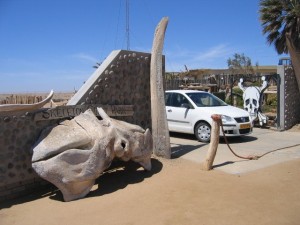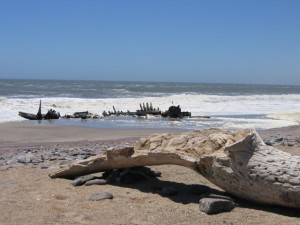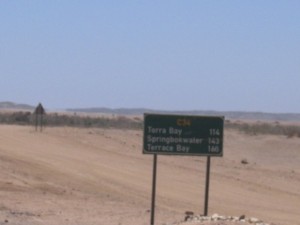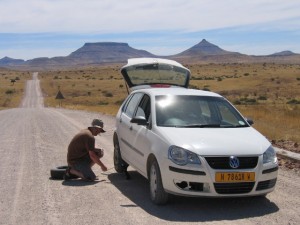Namibia’s Skeleton Coast is one of the finest and most unusual coastal wildernesses in the world. I’ve driven many famous roads and scenic drives and the Skeleton Coast is up there in my Top 5 memories of Driving Abroad.
The Coastal Road, the D32, runs from the old German colonial town of Swakopmund around 300KM North to the tiny settlement of Terrace Bay, though most visitors will turn off the road just South of Torra Bay which gives access to the Springbokwasser Gate which heads inland to Bergsig , and onto Khorixas.
Swakopmund is a pleasant little seaside town. Surrounded on all sides inland by the harsh Namib desert and to the West by the cold, often fog shrouded waters of the Atlantic, its Namibia’s main holiday resort and can get very busy in the December and January holiday seasons.Its a quirky place with some German colonial architecture and a selection of bars, restaurants and hotels, and makes a good spot to start or end your Skeleton Coast adventure.
Heading North from Swakopmund along the C34, the first ‘attraction’ which may cause you to pause is the Swakopmund saltworks, which is a collection of salt ponds which are a haven for birds. Arrive early before production begins at the saltworks to see many local wading birds plus migrant species between September and April.
The road then heads North through the National West Coast Recreation area, through flat , arid plains to Henties Bay around 70km North of Swakopmund. Henties Bay or Hentiesbaai, is a quiet little place for most of the year and comprises of a collection of bungalows on a bleak coast which is often whipped by chill winds. There are around 3000 ‘full time’ residents, though the population can increase five-fold in the summer months with visitors, mostly South Africans, attracted by the good fishing opportunities locally. Henties Bay has a couple of lodging options and bars/restaurants, and I spent an enjoyable night there in bars mostly frequented by locals rather than holiday makers.
There are a couple of walking trails starting at Henties Bay, one passing Cape Farilhao where the ruins of an old lighthouse can be seen.Theres also a 9 hole golf course leading down to the beach and the town makes a useful stopping point on the Skeleton Coast drive.
Heading North, the next ‘attraction’ is the Cape Cross Seal Reserve, 55 miles North of Henties Bay.This is the largest Cape Fur Seal colony in Namibia with as many as 250,000 honking, lumbering beasts on the beach at any time. Be warned -it tends to smell! The breeding season between November and December has the largest concentration of animals and is not a time for the squeamish as mortality rates amongst pups are high and its possible you may see lost pups, some crushed by adults and others picked off by predators such as Jackals.
Cape Cross was the site of the furthest southerly landing in Africa by a European when Diego Cao landed here is 1485. He erected a stone cross at the site of the landing, which was later moved to Berlin, to be replaced by a couple of replica crosses. Around 1900, there was a port at Cape Cross and a small community of guano collectors. Their remains are to be found in a small graveyard near the shoreline.
North of Cape Cross, the National West Coast Recreation area becomes the Skeleton Coast National Park. You enter from the South by the Ugabmund gate at the Ugab River around 200km North of Swakopmund. Theres an entrance fee of around $15 per person. Last entry is at 3pm each day in order for vehicles to make the two hour /120KM drive to the Eastern Gate at Springbokwasser (or vice versa if you’re travelling North/East to South). Note that it isn’t usually allowed to enter and exit through the same gate. Vehicles are logged on entry so the staff at each gate need to reconcile vehicles entering and leaving. If drivers could exit through either gate this could lead to confusion over whether a vehicle was still in the park. No motorcycles are allowed to drive the coast.
This all may seem like over caution, until you consider what we’re dealing with in driving the Skeleton Coast. The name says it all. The drive is likely to be one of the loneliest and weirdest you’ve ever undertaken. You’ll see few other vehicles as you drive on a road of packed salt , with shifting swirling sand on the road and a weird light which causes sky, sea and horizon to blur into a mirage like effect.When I drove the road, the feeling of isolation and vulnerability was increased by the fact that I’d blown a tyre so had to employ my spare. I therefore had to drive through 200 miles of hostile terrain with no room for error in the form of another puncture!
The name Skeleton Coast seems to have been coined in the 1930’s with the disappearance of an aircraft trying to break the solo record in flying from London to Cape Town, but loss of shipping on this hazardous coast had begun long before that and numerous wrecks are scattered along the beaches and rocky approaches to the shore. As Jeff Dawson describes in ‘Dead Reckoning’ his excellent account of the stranding of the crew of the Dunedin Star in 1942 – “The Skeleton Coast is Africa’s Bermuda Triangle. Here, where the arid Namib Desert air collides with the Benguela, a flow of icy water bearing due North from Antarctica, a blanket of fog sits permanently along the coast, stretching as far as ten miles inland and even further out to sea, rendering navigation impossible, confounding sailors with distinctly untropical temperatures.”
You can obtain maps of the various wrecks, many which lie as rusting skeletons on the beaches. However, the corrosive salty air soon reduces the skeletal frames to nothing and few are worth making the arduous hike over the dunes to see. The Winston, South West Sea, Atlantic Pride,Luanda, Montrose, Karimona and Suiderkus are just some of the vessels which met their end on the beaches of the Skeleton Coast. One can only imagine the terror of the ships’ crews washed ashore, shivering awaiting rescue on the one of the worlds most hostile coasts.
As you approach the skull and cross bones entrance gate, theres a signpost to the 1970 wreck of the fishing boat ‘Winston’. Don’t be tempted to drive to it as you’re more than likely to get stuck. You’ll need to brave the lashing wind and hike over the salt pans. Further along, the road passes close to the shore and you should be able to see the rusting remains of the ‘South West Sea’ wrecked in 1976. You also pass some abandoned industry in the form of an old oil rig and diamond mine.
Eventually you’ll reach the turn off on the C39 which heads to the Eastern entry point to the Skeleton Coast, Springbokwasser Gate. If you carry on heading North you’ll reach the seasonal fishing village of Torra Bay which has few resources but excellent sea fishing. The camp is only open for a few months in the summer and booking is recommended –the camp is run by Namibia Wildlife Resorts- www.nwr.com.na. Beyond Torra Bay is the Uniab River Delta which is an excellent bird watching spot with a couple of walking trails.Theres also the wreck of the Atlantic at the mouth of the river.
Terrace Bay is the last settlement on the coast and comprises of a store and petrol outlet, though once it was the site of a long extinct mining operation. Its possible to drive another 14km North to Seal Beach where the road ends, 380 km from where you began in Swakopmund.
Though you could make the drive in a single day, its more leisurely to break it up with a stop en-route. Henties Bay has a few accommodation options and a tourist office –http://www.hentiesbaytourism.com/
Theres also a hotel 4km North of Cape Cross- the Cape Cross Lodge. There are camping sites at Terrace Bay as mentioned above and 3 isolated sites at Jakkalsputz, Mile 72 and Mile 108, all managed by Namibia Wildlife Resorts.
There is no dedicated Skeleton Coast website but you should get more info via this link –
https://www.info-namibia.com/activities-and-places-of-interest/kaokoveld/skeleton-coast
For more info on driving and car rental in Namibia, see my Namibia page. If you are a car rental company operating in Namibia, or a tourism company offering Skeleton Coast tours and would like to feature on DriverAbroad.com please check details on our Partnering page or contact us on ADriverAbroad@Outlook.com .
Although I try and keep the information in the site updated as much as possible, in a rapidly moving world, situations can change daily. Therefore please use the site as an approximate guide, and in conjunction with other resources in order to form your view on driving conditions, roads, safety etc.









